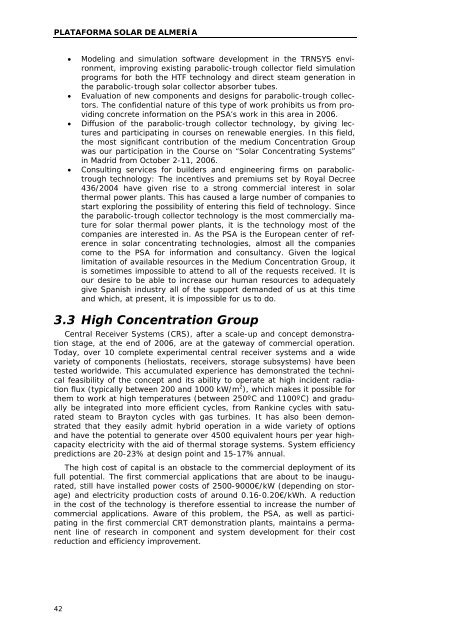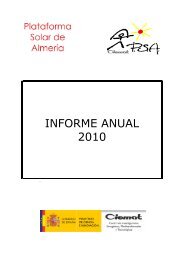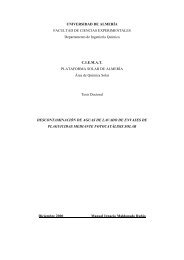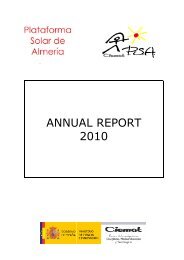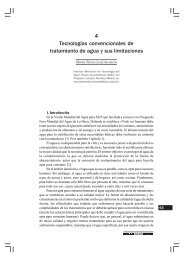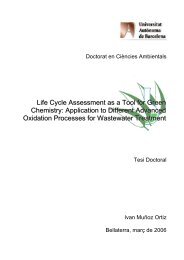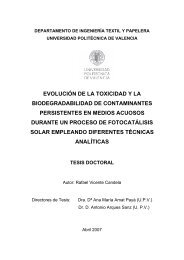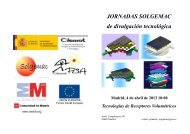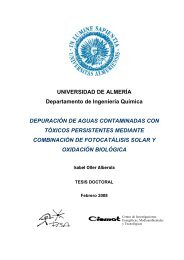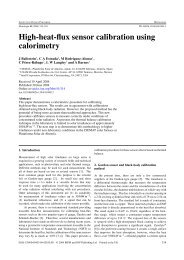Annual Report 2006 - Plataforma Solar de AlmerÃa
Annual Report 2006 - Plataforma Solar de AlmerÃa
Annual Report 2006 - Plataforma Solar de AlmerÃa
You also want an ePaper? Increase the reach of your titles
YUMPU automatically turns print PDFs into web optimized ePapers that Google loves.
PLATAFORMA SOLAR DE ALMERÍA<br />
• Mo<strong>de</strong>ling and simulation software <strong>de</strong>velopment in the TRNSYS environment,<br />
improving existing parabolic-trough collector field simulation<br />
programs for both the HTF technology and direct steam generation in<br />
the parabolic-trough solar collector absorber tubes.<br />
• Evaluation of new components and <strong>de</strong>signs for parabolic-trough collectors.<br />
The confi<strong>de</strong>ntial nature of this type of work prohibits us from providing<br />
concrete information on the PSA’s work in this area in <strong>2006</strong>.<br />
• Diffusion of the parabolic-trough collector technology, by giving lectures<br />
and participating in courses on renewable energies. In this field,<br />
the most significant contribution of the medium Concentration Group<br />
was our participation in the Course on “<strong>Solar</strong> Concentrating Systems”<br />
in Madrid from October 2-11, <strong>2006</strong>.<br />
• Consulting services for buil<strong>de</strong>rs and engineering firms on parabolictrough<br />
technology: The incentives and premiums set by Royal Decree<br />
436/2004 have given rise to a strong commercial interest in solar<br />
thermal power plants. This has caused a large number of companies to<br />
start exploring the possibility of entering this field of technology. Since<br />
the parabolic-trough collector technology is the most commercially mature<br />
for solar thermal power plants, it is the technology most of the<br />
companies are interested in. As the PSA is the European center of reference<br />
in solar concentrating technologies, almost all the companies<br />
come to the PSA for information and consultancy. Given the logical<br />
limitation of available resources in the Medium Concentration Group, it<br />
is sometimes impossible to attend to all of the requests received. It is<br />
our <strong>de</strong>sire to be able to increase our human resources to a<strong>de</strong>quately<br />
give Spanish industry all of the support <strong>de</strong>man<strong>de</strong>d of us at this time<br />
and which, at present, it is impossible for us to do.<br />
3.3 High Concentration Group<br />
Central Receiver Systems (CRS), after a scale-up and concept <strong>de</strong>monstration<br />
stage, at the end of <strong>2006</strong>, are at the gateway of commercial operation.<br />
Today, over 10 complete experimental central receiver systems and a wi<strong>de</strong><br />
variety of components (heliostats, receivers, storage subsystems) have been<br />
tested worldwi<strong>de</strong>. This accumulated experience has <strong>de</strong>monstrated the technical<br />
feasibility of the concept and its ability to operate at high inci<strong>de</strong>nt radiation<br />
flux (typically between 200 and 1000 kW/m 2 ), which makes it possible for<br />
them to work at high temperatures (between 250ºC and 1100ºC) and gradually<br />
be integrated into more efficient cycles, from Rankine cycles with saturated<br />
steam to Brayton cycles with gas turbines. It has also been <strong>de</strong>monstrated<br />
that they easily admit hybrid operation in a wi<strong>de</strong> variety of options<br />
and have the potential to generate over 4500 equivalent hours per year highcapacity<br />
electricity with the aid of thermal storage systems. System efficiency<br />
predictions are 20-23% at <strong>de</strong>sign point and 15-17% annual.<br />
The high cost of capital is an obstacle to the commercial <strong>de</strong>ployment of its<br />
full potential. The first commercial applications that are about to be inaugurated,<br />
still have installed power costs of 2500-9000€/kW (<strong>de</strong>pending on storage)<br />
and electricity production costs of around 0.16-0.20€/kWh. A reduction<br />
in the cost of the technology is therefore essential to increase the number of<br />
commercial applications. Aware of this problem, the PSA, as well as participating<br />
in the first commercial CRT <strong>de</strong>monstration plants, maintains a permanent<br />
line of research in component and system <strong>de</strong>velopment for their cost<br />
reduction and efficiency improvement.<br />
42


